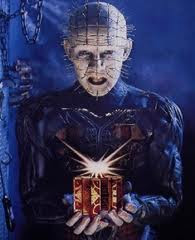The Monster in the Maze
“Asterius has a bull’s head, because his father was the big white bull Pasiphae fell in love with. Asterius has been shut up in a building designed by an Athenian inventor…the moment had come for them to cover up their secrets, and ultimately to be ashamed of them (Calasso, 11).” Asterius is the Minotaur, the monster that Daedalus designed the labyrinth to conceal. The concept of the maze is a prevalent theme in John Fowles novel The Magus. It is nearly impossible to separate the monster and the maze since the maze was designed for the monster. But who is the monster in Nicholas’ maze? Throughout Fowles novel Nicholas is struggling with a monster. It is unclear who that monster may be but nonetheless there is a beast stalking Nicholas through his labyrinth.
Could Joe be the monster? He first appears to Nicholas dressed as Anubis, a beastly creature with the head of a jackal and the body of a man. Joe is a shadowy figure that is always silently watching, stalking. He is always guarding, a person or a secret, similar to the monsters in mythology. Perhaps, Conchis is the fiend? There are many times is the narrative when Nicholas suspects Conchis of being more than the magician. Nicholas suspects that there is something sinister about Conchis, something beastly, he wonders if Conchis is a pervert. The depths to which Conchis’ maze takes Nicholas, the seemingly boundless manipulation, support that Conchis could be more the magician. Conceivably any of the female leads could be the monster. Allison is possibly the monster for having selfishly killed herself and haunted Nicholas’ thoughts. Perhaps it is Julie and her flirtatious character or Lily with her monstrous manipulation of Nicholas. All the players look the part; feasibly there could be more than one monster in Nicholas’ maze.
At the trial, the aforementioned participants and a few others from behind the scenes appear to Nicholas dressed in a monstrous fashion. The figures marched in front of Nicholas, in elaborate and ghastly costume, at the trial are an illustration of the link between the monster and the maze. “The long line of black-carnival puppets stared at me from the floor. I stared down the line: the stag-devil, the crocodile-devil, the vampire, the succubus, the bird-woman, the magician, the coffin-sedan, the pierrot-skeleton, the corn-doll, the Aztec, the witch (Fowels, 503).” All of the people inside the costumes were involved in the construction of Nicholas’ maze, all of the people appear in the garb of monsters and no doubt Nicholas thinks of them as beastly; even more so without their costumes. Unfortunately for Nicholas they set him free from their constructed maze and Nicholas is left to search for his still unidentified monster; for identifying the monster brings about a conclusion, an answer and “an answer is always a form of death (Fowles, 626).”
Still obsessed with finding his monster, so that he may slay it, Nicholas continues the investigation that leads him to Mrs. De Seitas; the mother of Lily and Julie. Since the neither of the twins is the monster maybe the woman that raised them to be so deceitful is the true fiend. Although disgusted by her, she is clearly not the monster he seeks. However, he does view her and her daughters as devilish. Nicholas remarks, “now I understand why you grow so many flowers.’ She shifted her head, not understanding. I said, ‘To cover the stink of sulphur’ (Fowles, 602).” The secrets, lies, manipulations, and betrayals keep Nicholas always on the hunt for identifying the ogre in the shadows.
When he learns that Allison is alive and all the correspondence concerning her unfortunate suicide is a sham his rage leads him to believe that undoubtedly Allison must be the monster that has been pushing him through the labyrinth; the being that had been both leading him and stalking him through the maze. She had been there since the beginning, it was her fault--it was all her fault. She had somehow been responsible for getting him mix up in this experiment in which “monstrous liberties where taken with my [Nicholas] liberties (Fowles).” She was the only creature evil enough to do this to him. Yes, she had to be his monster and he must go slay her, metaphorically, but where does one find the dead or rather falsely dead.
Even though Allison is very much alive she might as well exist only in a spirit realm that Nicholas could not enter; for despite his best efforts he had no way to find her. When Allison finally reveals herself to Nicholas he accuses her of being his ever present monster. She in turn makes the same accusation of him. In that pivotal moment, in the park, when Nicholas slaps Allison it is unclear if the truth becomes apparent to Nicholas. But to the reader it is right there just as it has been all along. The creature that knows his secrets, the being that both propels him forward while stalking him, the ultimate evil, the monster; is Nicholas himself. “A creature who would never be able to go back to being either beast or man. He would be a hybrid (Calasso, 11).”






